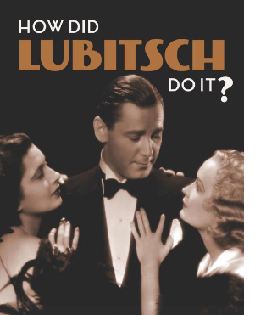CineSavant Column

Hello!
I finished Joseph McBride’s major new film book How Did Lubitsch Do It? a few days back, and needed some time to think about what I’d read. Really good books about directors don’t come along very often, and of the newer breed this one joins Bernard Eisenschitz’s book on Nicholas Ray, Foster Hirsch’s on Otto Preminger and Alan Rode’s recent study of Michael Curtiz as a fascinating, illuminating read.
McBride has written some of the closest studies of John Ford, who he was able to interview; the great Ernst Lubitsch passed far earlier in 1947, yet left his mark as one of the most influential directors in Hollywood history. McBride digs into the producer-director’s roots in Germany, when he worked with Max Reinhardt on the Berlin stage. Lubitsch transplanted his talent to America early in the 1920s and was thus firmly established before the arrival of waves of refugees from the Hitler regime. Interestingly, although his special gift was comedy, Lubitsch’s extravagant epics caught the attention of Hollywood, which was always on the prowl to snap up ‘artistic’ European directors. He worked for stars like Pickford and moved between several studios, gaining a reputation for bedroom farces pitched at a higher level of wit than those from homegrown directors like Cecil B. DeMille.

Author McBride never lets go of his prime mission, which is to try to isolate, explain and define what was meant by ‘the Lubitsch Touch.’ Even in silent films, Lubitsch consistently invented comic situations loaded with innuendo and irony, that illuminated visual jokes that seemed to spring from the characters, as opposed to being imposed on them by a gag writer. Often slyly suggestive, a perfect Lubitsch Touch construction was understated, sometimes ironic but seldom cynical. A ‘shared understanding’ generated by direct author-viewer communication, a Lubitsch effect expressed his love for things European, elegant and sentimental.
McBride finds The Touch in German films made during WW1 and several key silent comedies in Hollywood. The style really came together when sound was added. Toying with the possibilities of the musical format, Lubitsch confected affectionate, playful & naughty romantic comedies with Maurice Chevalier. The big Lubitsch films are given a serious going-over, examined from multiple angles using a wealth of research. McBride adds his own interpretations to trends in the director’s work, praising some pictures to the skies (Trouble in Paradise) and surprisingly, not others (Bluebeard’s Eighth Wife). The analysis of Trouble in Paradise convinces us that it may be the most sophisticated picture ever made. The show suggests all manner of sexual excess without once making anything overt, yet was shelved as wholly unacceptable when the Production Code was enforced.
McBride’s focused assessment of Ernst Lubitsch’s contribution is compared to that of Rouben Mamoulian, who is found wanting when he imitated Lubitsch’s style. The hothouse exercises in style and glamour of Paramount’s hot director Josef von Sternberg were not to Lubitsch’s taste. Sternberg’s career took a nosedive when Lubitsch became the Paramount production chief for a couple of years, but we are assured that Lubitsch did not have it in for his fellow director. When he gets his directing career going again, Lubitsch intersects with more writers (Walter Reisch, Charles Brackett, Billy Wilder) and continues to develop his signature style. Unlike some directors Lubitsch was a friend and true collaborator with his writers, challenging them to perfect their jokes into constructions that paid off in extra, even funnier jokes. Ninotchka, The Shop Around the Corner, To Be Or Not To Be and Heaven Can Wait are all originals with few repeated elements, by turns satirical, sentimental, politically savage and sweetly fantastic.
Although some of us tend to relate to Ernst Lubitsch through his most vocal, loyal acolyte Billy Wilder, McBride uses Wilder mainly to help zero in on the concept of The Lubitsch Touch. Wilder often returned to film subjects that seemed to be direct attempts to recapture Lubitsch’s elegant perfection of form; and often adapting the work of some of the same European playwrights Lubitsch favored. The book’s title is derived from a motto Wilder kept on his office wall, an oath-reminder to remember the Master.
Joseph McBride’s holistic approach doesn’t try to sort Lubitsch into biographical and thematic pigeonholes, which makes the read an intense experience for film adepts that want their analysis thoughtful, straight and deep. McBride doesn’t button up a topic and move on, but instead keeps angles of study afloat in an ongoing discussion. A particular film title will bounce back scores of times when some scene or event becomes relevant again. Some readers may confuse this with repetition, but it begins to pay off when we think we’re gaining purchase on an understanding of what the elusive Lubitsch touch might be. Billy Wilder never claimed that his hommages to his mentor ever quite equalled the Master’s work. I think McBride gets as close as anybody to an understanding of Lubitsch’s twinkle-eyed genius.
Yes, the McBride How Did Lubitsch Do It? is a heavyweight item. Grab it when you have some solid reading time, and prepare some bookmark placeholders to allow a return to the good parts.
(How Did Lubitsch Do It? Columbia University Press, June 26 2018, 576 pages)
Thanks for reading! — Glenn Erickson



